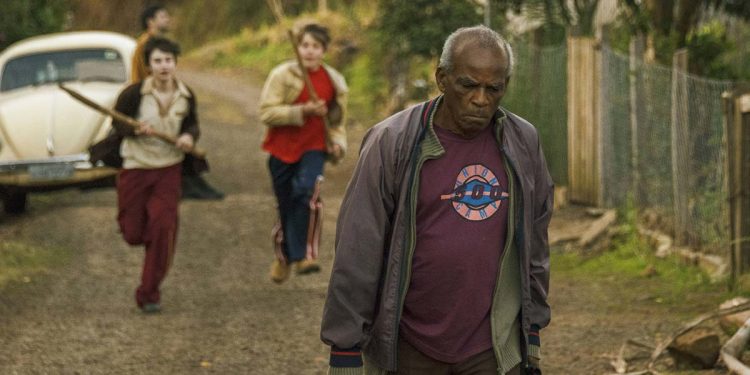Cinema continues to be a reflection of society, and the social and racial disruptions of the current times have been reflected in key titles of this year’s Toronto International Film Festival. One of the more explicit, and challenging, reflections of this is João Paulo Miranda Maria’s feature directorial debut, “Memory House”. “Memory House” is the latest in a line of Brazilian cinema that seeks to interrogate the country’s colonial past at a time when Brazil is experiencing its own disconcerting flirtation with fascism. With “Memory House”, Miranda Maria creates a hazy post-modern riff on loneliness and isolation that, by design, traps its audience in a disorienting hellscape of increasingly dwindling returns; every frame brings greater notes of complication and uncertainty as the film builds.

“Memory House” is a brief ninety minutes, but it makes use of each of those minutes to immerse the audience in a punishing and unflinching world which feels both achingly familiar and almost dystopian in the way its suffused with the worst of humanity. The story follows Cristovam, an elderly Indigenous-Black man who works at a milk factory in an affluent Austrian enclave in the south of the country. An early sequence establishes his complications, placing him across from his male boss and a female figure of authority. As the two, both white, sit across from him, united in their whiteness and privilege, the camera renders him isolated on the other side of the table. It’s the first of many explicit images of isolation that “Memory House” will build on. In that moment, Cristovam and his employers are negotiating a change of contract for him. His wage is being cut. But, calling it a negotiation feels disingenuous. Like often happens to those without power, Cristovam is bullied into an economic situation that renders him even more powerless.
From there, Brazil traces the unravelling of a man with little to live for. The ‘Memory House’ of the title is an abandoned house that Cristovam begins to inhabit in the early strands of the film. The house seems like an abandoned house, but also like one that Cristovam has known before reflecting the tone of ambiguity that runs throughout. Familiar, or not, the house is laden with objects and symbols that remind Cristovam of his past and these objects become central to Cristovam’s tentative reclamation of his past, launching himself against the whiteness that both surrounds and then oppresses him.
The house exists in a community that feels overwhelmed with whiteness. In a later scene, one of the town’s leaders announces their plans to secede from the rest of Brazil to a room full of mostly white community members. The point is obvious–to remain bound to Brazil and its indigeneity unsettles the white populace. Naturally, Cristovam’s presence complicates this and his isolation is made explicit and increasingly unsettling as Miranda Maria paints a bleak and unforgiving picture of age and race. “Memory House” and its bleak portrait of race relations reflect the unforgiving social situation sweeping across the world at the moment. There’s a narrative strangeness to the ways that the white community’s racism is undisguised, but if the explicitness is jarring, we soon realise that it’s part of the film’s own relentless dialectic. Benjamín Echazarreta’s camera shoots the film like a horror film, making us anticipate danger at every turn. And in a world of isolation for Cristovam, danger is ever present.
As Cristovam becomes an object of ridicule, the film follows his rebuilding of himself as a trenchant figure of indigenous power. The images later in the film as he dons a fateful costume are charged and impactful and it represents the ways that “Memory House” sometimes seems to work better as an invective against white supremacy than as a narrative feature. Miranda Maria does stronger work in his direction, than in his screenplay, which feels too often schematic to effectively key us into Cristovam’s point-of-view. Instead, the film maintains a level of opacity with Cristovam, making him a challenging hero to root for. That challenging nature, though, oddly becomes a central part of what makes “Memory House” so compelling even as its image become more repulsive than inviting. It is challenging, and then forcing us to look at the worse of humanity in the face and it’s a credit to its conviction that it maintains the level of surety throughout.
There are moments where its representation of Cristovam seems to complicate itself. His own sexism and bigotry gently nod at the ways that the entire community is consumed by social ills. A few brief sequences with two women of colour in the film betray the film’s own limited perspective on gender politics. A brief scene of a gay encounter feels even more peculiar. Instead, “Memory House” is more confident, if unnerving, when it allows Cristovam to confront his isolation in direct opposition to the white supremacy that surrounds him. The film’s end brings no catharsis or resolution but instead further complicates and disrupts our relationship with the film’s ethos. Few are likely to enjoy the abstrusity that Miranda Maria uses to represent the same hollowness inside Cristovam, but “Memory House” feels valuable in spite of, and because of, its level of difficulty.




